Health Protocols: Comprehensive Guidelines for Prevention & Wellness
Updated On: October 23, 2025 by Aaron Connolly
Understanding Health Protocols
Health protocols guide healthcare systems in keeping everyone safe and making care more consistent. Over the years, these frameworks have changed a lot, reacting to new illnesses, better tech, and our shifting understanding of what protects patients and staff.
Definition and Scope
A health protocol lays out systematic steps to keep people healthy and safe in medical settings. These guidelines help healthcare professionals stick to evidence-based practices, whether they’re treating patients or handling public health situations.
Health protocols span a huge range. Some focus on basics, like washing hands and sterilizing equipment. Others tackle complicated treatment plans for specific diseases.
Key areas covered by health protocols:
- Patient care procedures
- Infection control measures
- Emergency response plans
- Equipment maintenance standards
- Staff safety requirements
Clinical protocols zero in on patient treatment. They spell out the right steps for diagnosing, treating, and caring for certain conditions.
You might see flowcharts for managing diabetes or detailed steps for surgery.
Public health protocols take a wider angle. During COVID-19, we saw whole communities adopt rules for masks, distancing, and contact tracing.
Key Principles of Health Protocols
All solid health protocols have a few things in common. Standardisation makes sure every patient gets the same level of care, no matter who’s helping them.
Evidence-based practice sits at the heart of modern protocols. Professionals build these rules using up-to-date research and clinical data.
This way, treatments stay both safe and effective.
Clear communication is non-negotiable. Guidelines should use simple language so healthcare workers can follow them fast, especially when things get hectic.
Protocols need some flexibility too. For example, a heart attack protocol might need tweaks for older patients or those with other health problems.
Regular updates keep protocols fresh. What worked five years ago might not cut it today.
Risk management shapes how protocols get designed. Professionals spot possible dangers and set up steps to lower those risks.
This protects patients and keeps healthcare workers safe from job-related hazards.
Evolution of Modern Protocols
Health protocols have changed a ton in the last hundred years. Early on, doctors mostly relied on their own judgment, and hospitals didn’t always agree on best practices.
The 1990s brought a big shift with evidence-based medicine. Healthcare systems started insisting that protocols needed solid scientific backing, not just tradition or gut feeling.
Major developments in protocol evolution:
| Period | Key Changes |
|---|---|
| 1900-1950 | Basic hygiene protocols established |
| 1950-1980 | Infection control becomes systematic |
| 1980-2000 | Evidence-based guidelines emerge |
| 2000-2020 | Digital protocols and real-time updates |
| 2020-Present | Rapid protocol adaptation (COVID-19 era) |
COVID-19 really sped up protocol development. Teams had to whip up new guidelines fast as we learned more about the virus.
This showed how valuable flexible systems are—and how tough it is to keep everyone on the same page when things change quickly.
Now, protocols often use digital platforms. Electronic health records can nudge workers to follow the right steps for each patient.
That helps cut down on mistakes and keeps care consistent.
Artificial intelligence is starting to play a role too. Computer systems can sift through mountains of patient data to spot trends and suggest tweaks we might miss.
Core Prevention and Safety Measures
Good hygiene, keeping a safe distance, and using protective equipment form the backbone of strong health protocols. These habits help cut down infections and protect everyone’s well-being.
Hand Hygiene and Sanitation
We suggest cleaning your hands multiple times a day. Use alcohol-based rubs or wash with soap and water for at least 20 seconds.
Clean your hands right away:
- Before eating or touching your face
- After using the toilet or touching shared surfaces
- Before and after caring for someone sick
- After sneezing, coughing, or blowing your nose
Alcohol-based sanitiser works best when your hands aren’t visibly dirty. It usually kills germs faster than soap and water.
Keep sanitiser close by—at entrances, desks, common areas.
Quick tip: Set a reminder every couple hours to clean your hands. It’s easy to forget otherwise.
Try not to touch your eyes, nose, or mouth with unwashed hands. Germs get in most easily that way.
Social Distancing Guidelines
Aim for at least 2 metres of space from others when you can. This lowers your chance of catching something from droplets.
Distance matters most:
- Waiting in lines
- Walking through crowds
- Chatting for more than a few minutes
- Indoors with bad airflow
We think outdoor activities beat indoor ones whenever possible. Fresh air helps scatter any germs.
Stick to close contact with people you live with. Long face-to-face talks—even at a distance—raise the risk.
Heads up: Distance won’t cut it in packed or stuffy spaces. Layer up with other protective steps.
If you can, swap in-person meetings for virtual ones. It’s just less risky for everyone.
Use of Personal Protective Equipment
Face masks block respiratory droplets when you wear them right. Pick masks that cover your nose and mouth all the way.
How to wear a mask:
- Wash hands before putting on or taking off
- Don’t touch the front while wearing it
- Toss disposable masks after each use
- Wash cloth masks after every wear
For most daily stuff, surgical masks work well. N95s offer more protection but only if they fit right.
Gloves help for cleaning or caring for sick people. Change them between tasks, and never reuse single-use gloves.
Take off gear carefully so you don’t get germs on yourself. Remove gloves first, then the mask, and wash your hands right after.
Don’t: Wear the same mask for days. That just makes things worse.
Immunisation Protocols
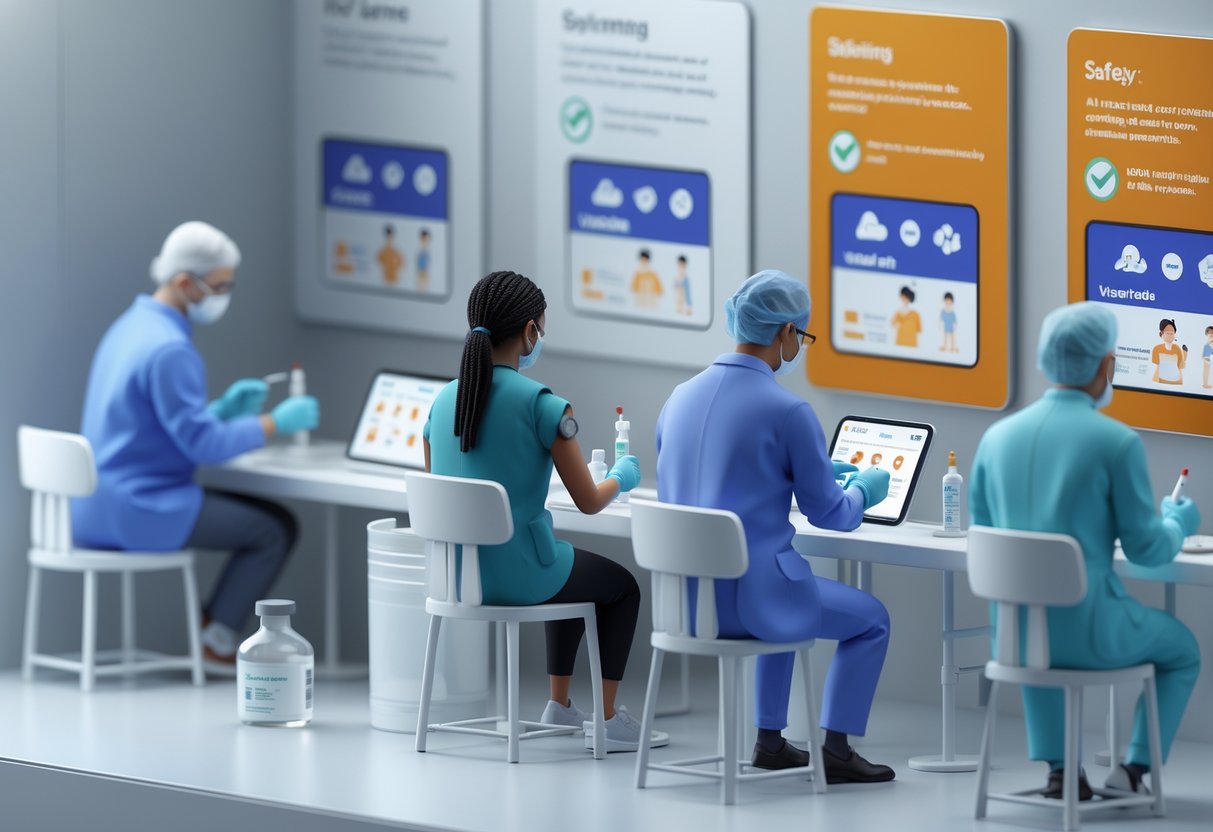
Immunisation protocols set clear steps for giving vaccines, timing them, and keeping patients safe from preventable diseases. They help providers stick to evidence-based schedules, spot risks, and adjust care for people who need extra protection.
Routine Vaccination Schedules
We stick to standard immunisation schedules from national health authorities. These schedules lay out which vaccines you need at different stages of life.
The typical childhood program covers 13 major diseases. We start shots at 8 weeks, using combo vaccines for diphtheria, tetanus, pertussis, polio, and Haemophilus influenzae type b.
Key ages for vaccines:
- 8, 12, 16 weeks: Primary shots
- 12-13 months: MMR and pneumococcal booster
- 3-4 years: Pre-school boosters
- 12-13 years: HPV vaccine
- 14 years: Teenage booster
Adult Schedules
Adults focus on staying protected and handling new risks. We recommend a flu shot every year for everyone over 50.
Main vaccines for adults:
- Tetanus/diphtheria: Every 10 years
- Pneumococcal: At 65 or for high-risk folks
- Shingles: Ages 70-79
- COVID-19: Follow the latest guidance
Contraindications and Precautions
We check every patient before giving vaccines to spot anything that might make it risky or less effective. Real contraindications are rare, but we take them seriously.
Absolute Contraindications
If someone had a severe allergic reaction to a shot or a vaccine ingredient, we don’t give that vaccine again. We also never give live vaccines to people with severe immune problems.
Temporary Precautions
If you’re pretty sick, we’ll hold off on vaccines until you’re better. Mild illness without a fever doesn’t stop us from immunising.
What we check before vaccinating:
- Past bad reactions
- Current meds
- Pregnancy
- Immune system issues
- Recent blood product use
Documentation
We write down all screening results and any reasons we hold off on shots. That way, we keep care on track and don’t miss chances later.
Protocols for At-Risk Populations
We offer special vaccine schedules for people who face higher risks from infections—like those with health issues, certain jobs, or specific lifestyles.
Immunocompromised Patients
These folks need extra vaccines and skip live ones. We work closely with specialists to time shots around treatments.
Chronic Medical Conditions
People with diabetes, heart, or lung problems get more protection from:
- Yearly flu shots
- Pneumococcal vaccines
- Early shingles vaccines
Healthcare Workers
Because of their jobs, healthcare workers get extra shots—like hepatitis B, yearly flu, and varicella if they’re not immune. We check their immunity through blood tests when needed.
Travel Medicine
Travelers might need special vaccines depending on where they’re headed. We start planning 4-6 weeks before the trip to make sure the shots have time to work.
Infection Control Procedures
Strong infection control comes down to three things: isolating infected people, keeping environments clean, and using antimicrobial medicines wisely. Together, these steps help stop infections from spreading in healthcare settings.
Isolation and Quarantine
We separate people who could spread infections by using isolation and quarantine. Isolation keeps sick patients away from healthy folks. Quarantine holds people who might be sick apart until we’re sure they’re in the clear.
Healthcare workers follow set rules in isolation rooms. We gear up with gloves, masks, and gowns. The type depends on how the infection spreads.
Contact precautions kick in for germs that spread by touch. Patients get private rooms, and we use gloves and gowns for all contact.
Droplet precautions protect against illnesses that spread through coughs and sneezes. We wear masks within three feet of these patients.
Airborne precautions are strictest. These germs float in the air, so patients need rooms with filtered air, and we use N95 masks.
Room choice matters a lot. Single rooms are best for isolation. If sharing is the only option, we pair up patients with the same infection.
We keep a log of everyone who enters isolation rooms. This helps us track exposures. Staff need to communicate clearly about what’s required for each patient.
Environmental Cleaning Standards
We clean healthcare spaces to get rid of germs and lower infection risk. Different spots need different cleaning levels depending on how risky they are.
Low-level disinfection works for things that touch healthy skin, like bed rails or tables. Most cleaning products do the trick here.
Intermediate-level disinfection kills most bacteria and viruses. We use this for surfaces that might get blood or body fluids on them, like blood pressure cuffs.
High-level disinfection wipes out almost all germs except some tough spores. We use this for gear that touches mucous membranes, like breathing equipment.
We stick to a cleaning schedule for different areas:
| Area | Cleaning Frequency | Disinfection Level |
|---|---|---|
| Patient rooms | Daily and after discharge | Low to intermediate |
| Operating theatres | After each case | High |
| Toilets | Multiple times daily | Intermediate |
| Common areas | Daily | Low |
We always clean before disinfecting. First, we remove visible dirt, then apply disinfectant and let it sit for the right amount of time.
Training staff is key. We show them which products to use and how to use them safely.
Antimicrobial Stewardship
We use antimicrobial stewardship to make sure we use antibiotics and other antimicrobial medicines properly. That’s how we help prevent antimicrobial resistance and keep these medicines working for everyone.
Germs adapt when we misuse antibiotics, and then the medicines stop working against them. Treating infections gets way tougher when that happens.
Using antibiotics the right way matters most. We stick to some core principles:
- Pick the right medicine for each infection
- Give the right dose for the right amount of time
- Choose medicines that target specific germs when possible
- Skip antimicrobials if they’re not needed
Culture testing lets us find out which germ is causing the infection. That way, we can pick the best medicine for the job.
Sometimes, we have to start treatment before the test results come in. As soon as we get results, we adjust the treatment if needed.
We keep track of antimicrobial use in our facilities. Pharmacists and doctors team up to review prescriptions and spot chances to use better medicines or stop unnecessary treatments.
Education plays a big role. We make sure healthcare workers get regular updates about resistance patterns and treatment guidelines.
Patients and families help too. We teach them to take medicines exactly as prescribed and never share antibiotics with anyone else.
Protocols for Chronic Disease Management
Managing chronic diseases isn’t just about medication. We need structured treatment plans that focus on preventing complications and keeping people well.
These protocols help patients and healthcare teams work together. Medication, lifestyle tweaks, and regular monitoring all play their part.
Diabetes Management Guidelines
Managing diabetes means combining blood sugar checks with lifestyle changes. Most patients check glucose levels several times a day and look for patterns.
Blood Sugar Targets:
- Fasting glucose: 4-7 mmol/L
- Post-meal glucose: Under 10 mmol/L
- HbA1c: Below 7% for most adults
Daily Management Steps:
- Monitor blood glucose before meals and at bedtime
- Take prescribed medications at the same times each day
- Follow meal planning with controlled carbs
- Exercise regularly—aim for 150 minutes each week
Check-ups every 3-6 months help us track progress with HbA1c tests. Eye exams and foot checks catch complications early.
Lots of patients use glucose meters or continuous monitors. Having real-time feedback makes staying on track a bit easier.
Warning: Don’t skip medications or insulin, even on days you feel fine.
Heart and Vascular Health Protocols
Managing heart disease means reducing risks for heart attacks and strokes. We focus on medication, lifestyle changes, and keeping an eye on the numbers.
Key Treatment Areas:
| Component | Target | Monitoring |
|---|---|---|
| Blood Pressure | Under 140/90 mmHg | Weekly at home |
| Cholesterol | LDL under 2.6 mmol/L | Every 3 months |
| Weight | BMI 18.5-24.9 | Monthly |
Daily Protocol Steps:
- Take blood pressure meds as prescribed
- Stick to a low-sodium diet (under 2,300mg daily)
- Get moving—30 minutes most days
- Avoid smoking and cut back on alcohol
Medication Types:
- ACE inhibitors for blood pressure
- Statins for cholesterol
- Aspirin for clot prevention
- Beta-blockers for heart rhythm
Cardiac rehab programmes offer supervised exercise and education. They last about 12 weeks and really help reduce hospital trips.
Here’s a quick tip: Track your blood pressure every day and share those numbers with your doctor each month.
Respiratory Conditions Protocols
Managing respiratory diseases means keeping airways clear and avoiding flare-ups. COPD and asthma need different plans, but the basics are similar.
COPD Management:
- Use bronchodilator inhalers twice a day
- Do breathing exercises for 10 minutes daily
- Stay away from irritants and pollutants
- Get your flu and pneumonia shots every year
Asthma Control Protocol:
- Use controller medications daily, even if you feel okay
- Find and avoid triggers like allergens or cold air
- Keep rescue inhalers handy all the time
- Check peak flow readings to track lung function
Inhaler Techniques: A lot of people use inhalers wrong, which makes the medicine less effective. Breathe in slowly and deeply, then hold your breath for 10 seconds after inhaling.
Emergency Action Plans: Every respiratory patient needs a written plan for when to increase meds or get emergency help. These plans usually use a traffic light system based on symptoms.
Pulmonary rehab programmes mix exercise with education. They typically run 8-12 weeks and can make a real difference in breathing and quality of life.
Cancer Protocols and Preventive Strategies

Cancer protocols focus on three big things: finding cancer early, making treatment plans that fit each person, and giving patients the info they need. These steps save lives and make treatment more effective.
Screening and Early Detection
Screening finds cancer before symptoms show up. Early detection makes treatment easier and more likely to work.
Common screening tests include mammograms (breast cancer), Pap smears (cervical cancer), and colonoscopies (bowel cancer). Women usually start breast cancer screening at 50, and cervical screening begins at 25.
Key screening guidelines:
- Breast cancer: Mammogram every 2 years from age 50-70
- Cervical cancer: Screening every 3-5 years from age 25-64
- Bowel cancer: Screening every 2 years from age 50-74
Some people need screening sooner or more often, especially if they have a family history or genetic risks like BRCA.
Pay attention to warning signs like lumps, a cough that won’t quit, changes in bowel habits, or unexplained weight loss. Don’t wait for a routine test if you spot these.
Many clinics use electronic health systems to track screening results. This helps doctors follow up on abnormal results faster.
Treatment Planning and Monitoring
Doctors use set protocols to treat cancer, based on research and best practices.
Treatment plans depend on the type of cancer, how far it’s spread, and the patient’s health. The medical team looks at all these factors before choosing a treatment.
Common treatment approaches include:
- Surgery to remove tumours
- Chemotherapy to kill cancer cells
- Radiation therapy to target specific areas
- Immunotherapy to boost the immune system
Regular monitoring during treatment is crucial. Blood tests, scans, and physical exams show how well things are going. Doctors can tweak the plan as needed.
Most cancer centres use teams of specialists working together. You might see surgeons, oncologists, radiologists, and specialist nurses all involved.
Managing side effects is part of the protocol too. It helps patients keep their quality of life during treatment.
Patient Support and Education
Cancer patients need clear, honest info about their diagnosis and options. Good education helps people make choices that fit their lives.
Healthcare providers should break down treatment plans in simple language. Patients need to know what to expect, including side effects and recovery time. Written materials and handouts help reinforce these talks.
Key support services include:
- Nutrition counselling for healthy eating
- Pain management programmes
- Mental health support and counselling
- Financial assistance programmes
Hospitals often run patient education classes. These cover managing side effects, staying active, and preparing for recovery. Family members are usually welcome too.
Support groups connect patients with others who’ve been through similar things. Some meet in person, others online. It can really help to talk to someone who gets it.
Cancer charities like Macmillan and Cancer Research UK offer free resources, helplines, and practical advice for patients and families.
Oral Health Protocols
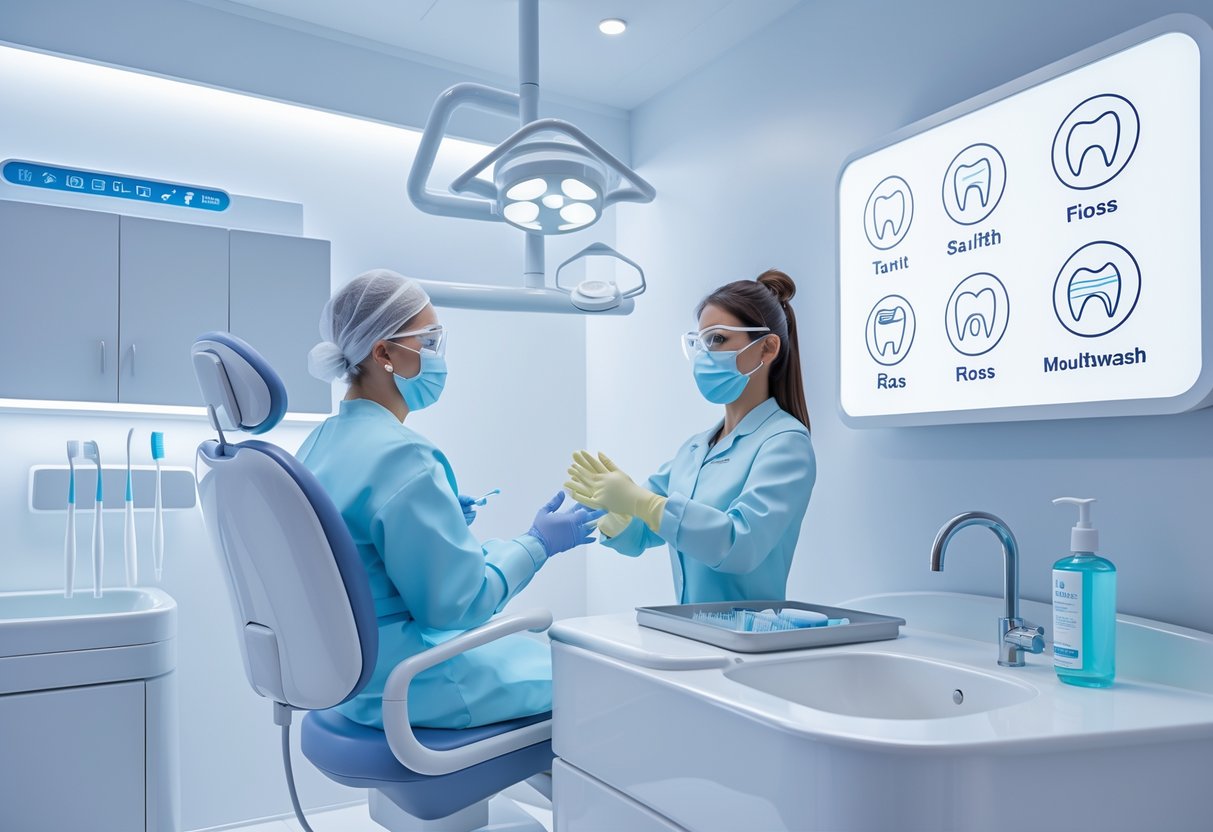
Keeping your mouth healthy takes daily routines, preventive care, and extra attention during pregnancy. These steps help stop dental problems and protect your overall health.
Dental Hygiene Best Practices
Brush your teeth twice a day for two minutes each time. Use a soft-bristled toothbrush and fluoride toothpaste.
Spend about 30 seconds on each part of your mouth. Don’t forget to brush your tongue to get rid of bacteria.
Daily routine checklist:
- Brush after breakfast and before bed
- Floss between teeth every day
- Use alcohol-free mouthwash
Swap out your toothbrush every three months. Keep it in a clean, dry spot.
Other supplies we like:
- Interdental cleaners for tight spaces
- Lip balm (petroleum-free)
- Saliva substitute if your mouth feels dry
See your dentist every six months for a cleaning and check-up. Catching problems early makes them easier to fix.
Protocols for Oral Disease Prevention
Poor oral health can raise your risk of pneumonia and other infections. Bacteria from dental plaque might end up in your lungs if you’re not careful.
Risk factors to look out for:
- Bleeding gums or gum disease
- Cavities in the last year
- Dry mouth from meds
- Smoking or tobacco use
Clean between your teeth daily with floss or interdental brushes. Toothbrushing alone misses a lot.
Warning signs you shouldn’t ignore:
- Bad breath that won’t go away
- Loose or sore teeth
- Red, swollen, or bleeding gums
- White patches in your mouth
Hospital patients need special oral care protocols. Studies show good oral hygiene can cut pneumonia rates by almost half.
High-risk patients include:
- Older adults
- People with chronic illnesses
- Immunocompromised patients
- Anyone on lots of medications
Oral Health Care During Pregnancy
Pregnancy hormones make gum disease and tooth problems more likely. Pregnant people need extra dental care.
Book a dental check-up early in pregnancy. Let your dentist know you’re pregnant and which meds you’re taking.
Safe dental treatments during pregnancy:
- Routine cleanings
- Fillings if needed
- Emergency dental care
- Local anaesthetics when necessary
If you have morning sickness, brush gently. Rinse with water or fluoride mouthwash after vomiting.
Pregnancy-specific tips:
- Use a softer toothbrush if your gums are sore
- Get more calcium and vitamin D
- Skip sugary snacks between meals
- Drink plenty of water
Untreated dental infections can affect your baby’s health, so don’t put off necessary treatment.
Gum disease links to premature birth and low birth weight. Good oral health protects both you and your baby.
Wellness and Lifestyle Guidelines

Wellness really comes down to three things: eating well, moving more, and keeping stress in check. These basics lay the groundwork for feeling better and performing at your best.
Nutritional Protocols
We should focus on nutrient-dense foods that actually fuel us. That means lots of veggies, lean proteins, whole grains, and healthy fats.
Daily Nutritional Targets:
- 5-9 servings of fruits and veggies
- 25-35 grams of fibre
- 0.8-1.2 grams of protein per kilo of body weight
- 6-8 glasses of water
Meal timing matters, too. Eating every 3-4 hours helps keep your energy steady and avoids those blood sugar crashes.
Foods to put on your plate:
- Leafy greens like spinach and kale
- Fatty fish such as salmon or mackerel
- Nuts and seeds
- Whole grains like oats and quinoa
- Berries and citrus fruits
Cutting back on processed foods, sugar, and refined carbs lowers inflammation. You might notice more energy and better sleep pretty quickly.
Physical Activity Recommendations
Most guidelines say to aim for 150 minutes of moderate activity or 75 minutes of vigorous activity each week. Breaking it up makes it doable.
Weekly Activity Goals:
- 30 minutes of moderate exercise, 5 days a week
- 2 strength training sessions
- Move every hour, even if it’s just a stretch
Simple stuff counts—walking, cycling, swimming, or even gardening all add up.
Strength Training Basics:
- Work all the major muscle groups
- Do 2-3 sets of 8-12 reps
- Include squats, push-ups, planks
- Take rest days between sessions
You don’t need a fancy gym. Bodyweight exercises, daily walks, and online workout videos work just fine.
Quick ideas to move more:
- Take the stairs instead of the lift
- Walk during phone calls
- Park further away
- Stretch while watching TV
Stress Management Approaches
Chronic stress hits our bodies hard. It messes with our sleep, weakens our immune system, and just makes everything feel heavier.
We need real, practical ways to handle the daily pressure. Sometimes, it’s about finding what works for you, even if it takes a bit of trial and error.
Proven Stress Reduction Methods:
- Deep breathing exercises (4-7-8 technique)
- Meditation or mindfulness practice
- Regular sleep schedule (7-9 hours nightly)
- Social connections and support networks
Daily Stress Management:
| Technique | Time Needed | Best For |
|---|---|---|
| Deep breathing | 2-5 minutes | Immediate relief |
| Meditation | 10-20 minutes | Long-term calm |
| Physical exercise | 20-30 minutes | Energy release |
| Social contact | 15-30 minutes | Emotional support |
Sleep quality really shapes how we handle stress. Try to keep your bedtime steady—your body likes routine.
A relaxing evening helps too. Maybe skip the phone before bed, and keep your room cool and dark if you can.
Setting boundaries matters more than we admit. Saying no isn’t always easy, but it keeps us from drowning in commitments.
Delegate when you can, and don’t forget to take breaks. Even a few minutes away from your desk can make a difference.
Protocols in Healthcare Settings
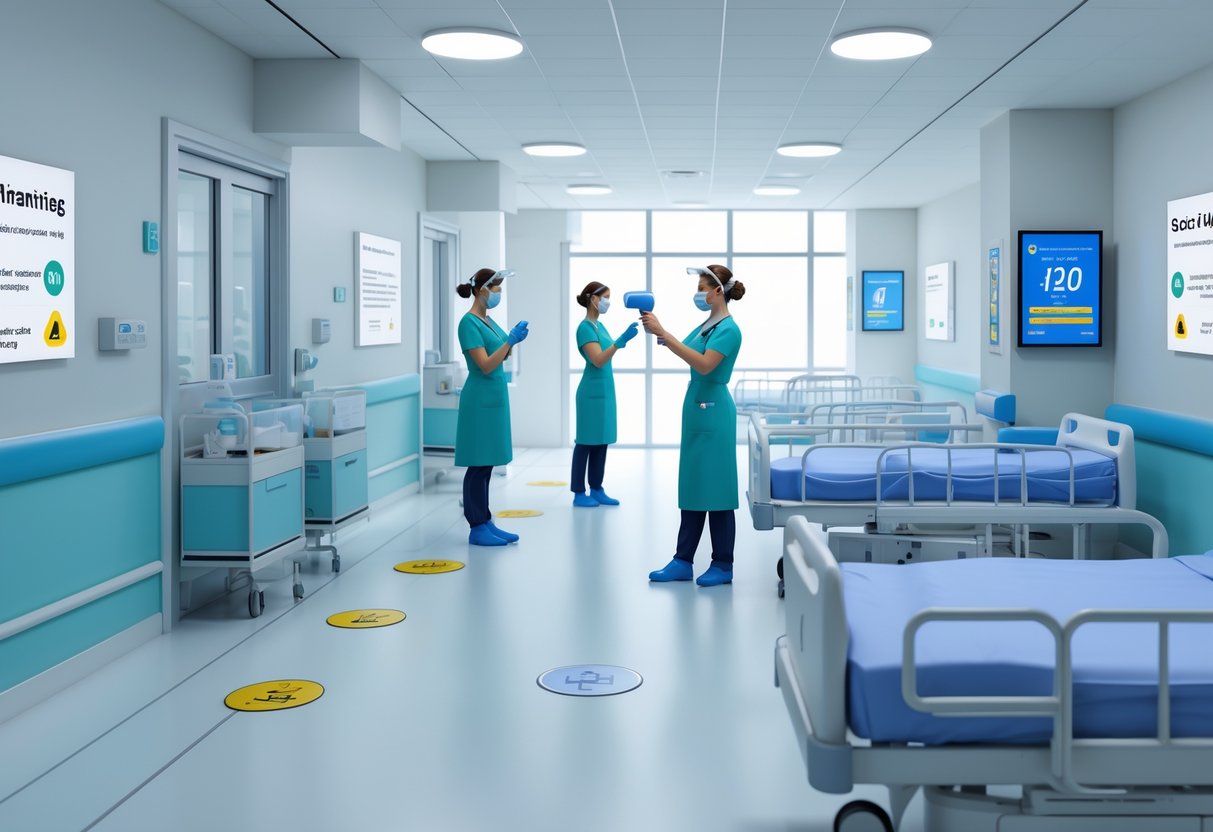
Healthcare protocols hold everything together in medical settings. They guide safe, consistent care and make sure everyone—patients and staff—stays protected.
These guidelines don’t just sit in a binder; they shape daily decisions and routines.
Clinical Practice Guidelines
Clinical practice guidelines set the standard for quality care. They give healthcare professionals clear recommendations, all grounded in current research and expert agreement.
The World Health Organisation calls guidelines tools for better decision-making. They lay out treatment options and explain how to get the best results.
Key components of effective clinical guidelines include:
- Systematic review of current evidence
- Assessment of treatment benefits and risks
- Clear recommendations for specific situations
- Regular updates based on new research
Guidelines cut down on random differences between healthcare providers. When everyone sticks to evidence-based protocols, patients get more reliable care—no matter who’s on shift.
The most useful guidelines blend research with hands-on experience. They actually work in real clinics, not just in theory.
Hospital Safety Standards
Hospital safety standards keep patients safe from avoidable harm. These protocols cover infection control, medication checks, equipment cleaning, and emergency responses.
Essential safety protocols include:
- Hand hygiene procedures before and after patient contact
- Medication verification using multiple checkpoints
- Equipment sterilisation and maintenance schedules
- Emergency response procedures for critical situations
The World Health Organisation says one in ten patients gets harmed during hospital care. That’s a lot, and many incidents could be stopped with better safety protocols.
Infection control stands out as a huge focus. Healthcare-associated infections hit up to 10% of patients, but studies show 35-55% of these could be avoided.
Safety standards don’t just protect patients—they also shield healthcare workers from injuries and infections.
Patient Education Practices
Patient education protocols help people actually understand their conditions and treatments. Informed patients recover better and make smarter choices.
Effective patient education includes:
- Clear explanations using simple language
- Written materials patients can review at home
- Demonstration of self-care techniques
- Opportunities for patients to ask questions
Education needs to fit different learning styles and literacy levels. Some folks like visuals, others want to hear things explained, and some prefer hands-on practice.
Providers need to check if patients really get it. Follow-up matters—sometimes people need another explanation or extra support.
Digital tools now play a bigger role. Online resources, apps, and videos can back up in-person teaching and help after discharge.
Protocols for Special Populations
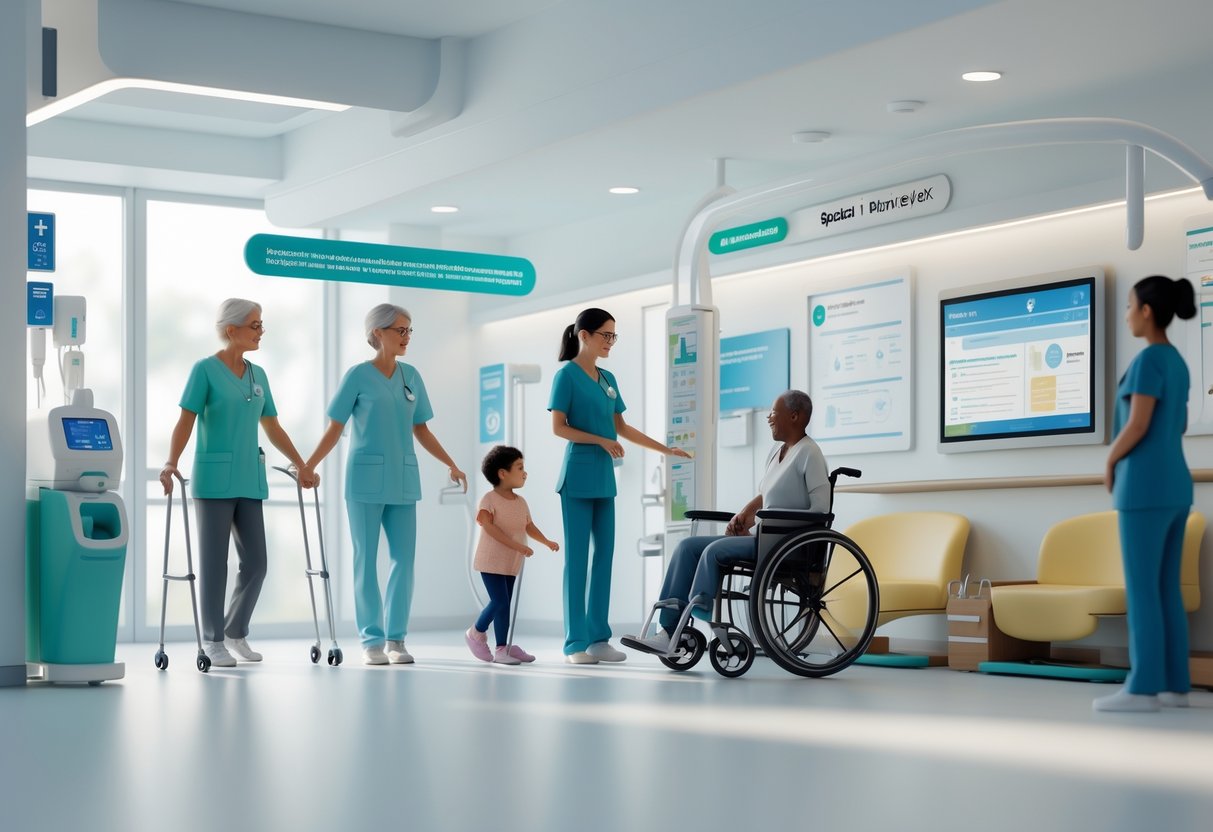
Different groups need their own health approaches because of unique physical changes, medication responses, and safety concerns.
Kids process drugs differently, older adults juggle more health issues, and pregnancy brings a whole new set of safety considerations.
Children and Adolescents
Kids’ bodies handle medications nothing like adults do. A newborn’s liver works at just 30% of adult capacity, then ramps up fast—sometimes even faster than adults by age three.
Key metabolic differences include:
- Higher total body water content
- Different organ size and blood flow
- Immature blood-brain barrier in infants
- Lower stomach acid levels
We adjust doses for kids by weight and age. Phase I metabolism—the breakdown of drugs—develops quickly, but Phase II (elimination) is less predictable.
Immunisation schedules need careful timing. The NHS sets up childhood vaccines to protect when kids need it most.
Safety considerations:
- Use child-resistant packaging
- Liquid forms for younger kids
- Monitor growth and development
- Watch for side effects unique to children
Doctors sometimes use adult data for kids, but that’s risky. We really need more pediatric trials to get dosing right.
Elderly Care Guidelines
Older adults face tricky challenges with lots of medications and age-related changes. Kidneys slow down, metabolism drops, and sensitivity to drugs goes up.
Physical changes affecting treatment:
- Reduced muscle mass and increased body fat
- Lower blood volume and slower heart rate
- Decreased liver and kidney function
- Changes in brain chemistry
Medication management becomes critical:
- Start with lower doses (“start low, go slow”)
- Watch for drug interactions
- Review medications regularly
- Try non-drug options first
Falls are a big risk. We focus on balance exercises, checking home safety, and reviewing meds that cause dizziness.
Common protocol adjustments:
- Longer monitoring periods
- More frequent check-ups
- Simpler dosing schedules
- Clearer labels and better organisation
Immunisations stay important—annual flu shots and pneumonia vaccines help prevent serious complications.
Pregnant Women Protocols
Pregnancy changes how the body handles medications, big time. Blood volume jumps by 50%, kidneys work faster, and hormones mess with drug absorption.
Physiological changes include:
- Slower stomach emptying
- Increased blood volume
- Higher kidney clearance rates
- Hormonal effects on liver enzymes
Safety considerations vary by trimester:
- First trimester: highest risk for birth defects
- Second trimester: generally safest period
- Third trimester: focus on labour and delivery effects
Doctors use pregnancy categories for medications. Only use drugs when the benefits clearly beat the risks. Some common meds, like certain painkillers, become off-limits during pregnancy.
Immunisation requires careful planning:
- Some vaccines are safe (flu, whooping cough)
- Others must be avoided (live vaccines)
- Timing matters for best protection
Essential monitoring includes:
- Regular blood pressure checks
- Tracking weight gain
- Blood sugar testing
- Foetal development checks
Providers keep pregnancy exposure registries to track how medications affect mothers and babies. This builds better safety data for the future.
Developing and Implementing Health Protocols

Building good health protocols takes a careful approach. We need solid research, practical training, and real feedback from the people using them.
Compliance systems matter, but so does listening to staff and making changes when things don’t work out as planned.
Evidence-Based Protocol Development
We start strong by digging into research and clinical guidelines before writing anything down.
Bringing in frontline staff early makes a huge difference. Doctors, nurses, and techs know what actually happens on the floor—they catch problems before protocols roll out.
Key elements for effective protocol development:
- Up-to-date research and evidence
- Input from staff who’ll use the protocols
- Clear, straightforward language
- Step-by-step procedures
- Defined roles and responsibilities
Local context matters, too. What works in a big hospital might flop in a small clinic. You have to consider equipment, staffing, and patient needs.
Good protocols explain the “why” behind each step. When people know the reason, they’re way more likely to stick with it.
Training and Compliance Monitoring
Training should be practical, not just theory. Staff need hands-on practice in safe settings before they try new protocols with real patients.
Everyone learns differently. Some prefer demonstrations, others like to read, and some want group discussions. Mixing it up helps everyone get it.
Essential training components:
- Comprehensive initial training
- Regular refreshers
- Competency checks
- Feedback and Q&A
We monitor compliance by watching and measuring how protocols get used. Tracking mistakes or barriers helps us know where to offer more help.
The best monitoring systems focus on support, not punishment. If someone struggles with a protocol, we need to understand why and give better training.
Audits and spot checks keep standards up, but open communication is just as important. Staff should feel okay reporting issues or suggesting fixes.
Continuous Quality Improvement
Quality improvement doesn’t end once protocols go live. We review how things are working and tweak them as new evidence or problems come up.
Healthcare workers’ feedback is gold. They spot real-world issues that developers might miss, and their ideas often lead to better protocols.
Key improvement activities include:
- Regular reviews of protocol effectiveness
- Looking at incidents or near-misses
- Updates for new research
- Collecting and reviewing staff feedback
We also track patient outcomes. If infection rates aren’t dropping or patients aren’t happy, it’s time to rethink the protocol.
Technology helps here. Digital systems can flag compliance problems and alert managers before things get out of hand.
Improvement works best when it’s constant and planned—not just when something goes wrong. Scheduled reviews beat waiting for a crisis every time.
The Future of Health Protocols

Health protocols are getting smarter and more personal by the year. Digital tools take over routine tasks, and treatments are starting to fit each person’s exact needs.
Digital Health and Protocol Automation
Digital health tools are shaking up how we run protocols. Automated systems now handle jobs that used to eat up hours of staff time.
Electronic health records pop up safety alerts on their own. If a patient’s meds might clash, doctors get a warning right away—way faster than any human could spot.
Artificial intelligence digs through thousands of cases to find what works best for different people. That kind of pattern-finding just isn’t possible for a single doctor.
Smart devices track patients in real time. Wearables monitor heart rate, blood pressure, and more, sending instant alerts if something’s off.
Telemedicine platforms come with built-in safety checks. They confirm patient identities, secure video calls, and keep data safe—no extra effort needed from staff.
| Digital Tool | What It Does | Time Saved |
|---|---|---|
| AI Drug Checking | Spots medication conflicts | 5-10 minutes per patient |
| Automated Alerts | Warns about vital sign changes | Instant notifications |
| Digital Scheduling | Manages follow-up appointments | 2-3 minutes per booking |
Personalised Medicine Approaches
Personalised medicine is changing the game. Protocols are starting to fit each person’s unique biology—one-size-fits-all is fading out.
Genetic testing now shows how patients process different drugs. Some people break them down fast, others slow. Knowing this helps doctors pick the right dose from the start.
Lifestyle data matters, too. Apps track sleep, exercise, and eating habits, shaping protocols that actually fit into real life.
Biomarkers in blood tests point to which treatments will work. Cancer patients now get medicines matched to their tumour type, not just standard chemo.
Risk prediction gets sharper with personal data. Family history, genetics, and lifestyle combine to show who needs extra screening or different protocols.
Digital twins—basically virtual models of a patient’s health—let doctors test treatments on a computer before trying them in real life. It’s still new, but it could save a lot of guesswork.
Smart protocols even adjust themselves as patients change or improve. Instead of rigid plans, we get flexible approaches that adapt to what actually works.
Frequently Asked Questions
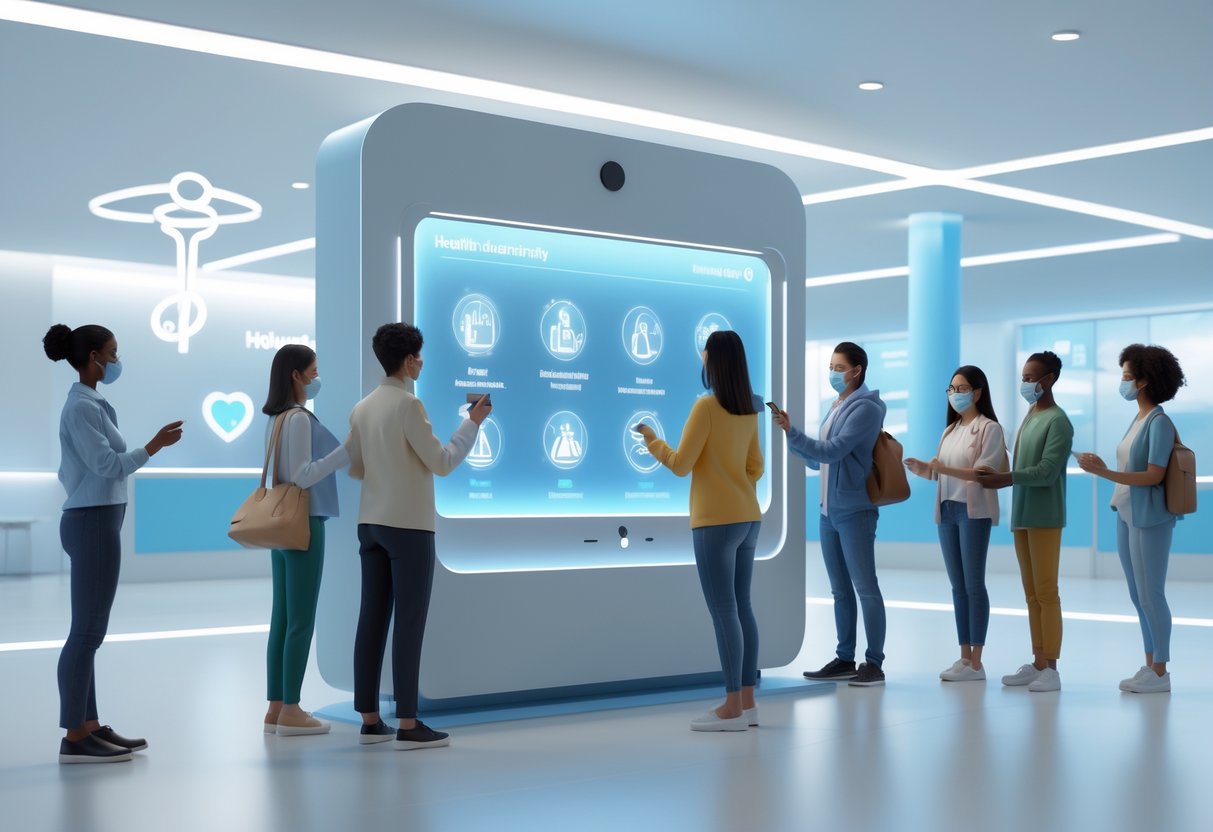
People ask a lot about COVID-19 prevention steps, isolation guidelines, and workplace rules. These questions clear up what to do when you’ve been exposed or feel sick.
What steps can I follow to help prevent catching COVID-19?
Wash your hands often with soap and water for at least 20 seconds. If you can’t find soap, use hand sanitiser.
Keep your distance from others, especially in crowded places. Try to avoid close contact with anyone who seems sick.
Wear a mask in busy indoor spaces like shops or on the bus. Make sure your mask fits well and covers your nose and mouth.
Clean surfaces you touch a lot, like door handles and light switches. Wipe down your phone and other devices every day.
Get vaccinated and stay up to date with any booster shots. Vaccines really do help protect you from getting seriously ill.
Could you tell me the latest guidelines for returning to work after COVID-19, please?
Wait at least 5 days after testing positive before you even think about going back to work. You need to be fever-free for at least 24 hours without taking any fever medicine.
Check your workplace’s policy because some places ask for a negative test or longer isolation.
Wear a well-fitting mask for 10 days after your isolation ends. This keeps your coworkers safer, just in case.
If you still feel sick after 5 days, stay home until you feel better. Don’t push yourself if you’re still wiped out or coughing.
What should someone do if they have been exposed to COVID-19?
Watch for symptoms for 10 days after you’ve been exposed. Look out for fever, cough, sore throat, or if you suddenly can’t taste or smell.
Take a test 3 to 5 days after exposure for the best shot at an accurate result. Test sooner if you start to feel off.
Wear a mask around others for those 10 days after you were exposed. It’s a small thing, but it protects your family and coworkers.
Stay home if you get any symptoms, even if they seem mild. If things get worse or you’re worried, call your GP.
What’s the current advice for isolating after testing positive for COVID-19?
Isolate for at least 5 days starting from when your symptoms began or the day you tested positive. Day 0 is the day your symptoms started or when you got that positive result.
You can stop isolating after day 5 if you’ve been fever-free for 24 hours without medicine. Your symptoms should be getting better, not worse.
Keep wearing a mask around others for 5 more days after you leave isolation. It’s not perfect, but it lowers the risk of spreading the virus.
If you still have a fever after 5 days, keep isolating until you’ve been fever-free for a full day. Don’t come out early if you’re still not feeling right.
How have the guidelines for COVID-19 isolation been updated this year?
Isolation now lasts 5 days for most people, not 10. Scientists found that most people aren’t contagious for as long as they once thought.
Now, you focus on being fever-free instead of just testing negative. Some folks test positive for weeks even when they’re not contagious anymore.
Mask-wearing after isolation has become more important. Those extra 5 days of masking help cover the time when you might still spread the virus.
Work and travel rules depend more on your workplace or the company you’re dealing with. There’s more personal judgment involved these days.
What actions should I take if I am showing symptoms of COVID-19?
If you notice even mild symptoms—like a runny nose or a slight cough—just stay home right away. Seriously, skip work, school, or any social plans.
Take a COVID-19 test as soon as you can. Home tests are pretty handy, but honestly, PCR tests at a clinic usually give you a clearer answer.
If your symptoms get worse or you have any underlying health conditions, reach out to your GP. If you start having trouble breathing, don’t wait—get urgent care.
Try to keep your distance from people you live with. If there’s a spare bathroom, use that, and definitely wear a mask when you’re around anyone else.
Jot down when your symptoms started and how they’re changing. That way, you’ll know how long you need to isolate and get a sense of your recovery timeline.

